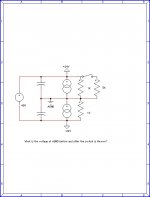Wow! All this over NOT putting an UNNECESSARY LED as a pilot light.
No, it's not. That's what it would have been had you simply left it at that, but you didn't and went on to bring Enid back from the grave and other assorted stuff regarding it screwing up the sound, etc. So no, it's NOT all over NOT putting an UNNECESSARY LED as a pilot light.
se
Enid Lumley was VERY smart, she had nearly finished her Masters degree (leading to a PhD) in psychology, I think it was UCLA. She had some sort of a 'breakdown' at this time, I think over a broken love affair. I don't know for sure, but I NEVER won an argument with her, she was THAT smart. She had 'golden ears' too, the best that I have ever been close to. To criticize her, when she is now in her grave, is not only pointless but misguided.
On the other hand you're on the way to become a guru.the majority of human beings are unable to comprehend.
When there actually are audible differences, yes. Very basic physics, in fact.
Well, how does physics explain the audible differences between different mains power plugs from the same manufacturer, connected to audio gear, made of different materials?
As for whether those difference are actually audible to me, you are welcomed to come to my home and conduct any blind test you may wish. You can send a representative, if you wish.
People who build gear for their studio copying famous designs. Any design have limitations, and their respective designers know them well. People who copy them don't. That's why problems happen more often than when other people design their own gear, less famous, or even unknown.
Who are you referring to? Is it people you know and can name, or is it just an amorphous statement?
Well, how does physics explain the audible differences between different mains power plugs from the same manufacturer, connected to audio gear, made of different materials?
Basic EM theory and power supply design. When you're ready to move beyond an interest in personalities and brands, I can recommend some excellent introductory texts. In the meantime, jneutron has posted quite a few excellent treatments of power feeds, and they're very worth reading.
Let's talk about 'balance'.
Why?
This is not the issue, and you know it!
The LED can run between the + and - rails directly, (series 5K or 2 series 2k5 if you have doubts about Thevanin!)
But you know all of that.
This is an evasion of a direct question.
Why are you diverting to questions about power cords when you have just stated that this thread is about LED indicators ??
Point AGND appears to be grounded, so the voltage there will be zero whatever position the switch is in.john curl said:Let's talk about 'balance'.
With the switch open the +24V and -24V points will be at the stated voltages, because of the 1K resistors which prevent the supply from being totally floating at DC. Close the switch and the voltages will shift - if my arithmetic is correct the '-24' will become -26.1818V and the '+24' will be 21.8181V.
If this shift disrupts the circuit (presumably modelled here by the 1k plus CCS) then that is the result of having a DC supply which is almost floating for DC purposes, yet grounded for AC. I assume there appeared to be a good reason for this unusual design.
DF96, it is a little more complicated than this simple example, but the principle is correct. Balance is useful and 'necessary' in the CTC Blowtorch.
Enid Lumley... yadda yadda yadda
Why don't you address the point of my post, John, instead of wandering off on some obfuscation?
She had 'golden ears' too...
Any charlatan can have "golden ears," because they never have to actually demonstrate their claimed abilities.
se
If you need balance, why not insist on it by having suitable supply arrangements? It seems perverse to design a circuit which requires exactly balanced supply rails, then run it from a PSU which is guaranteed to provide unbalanced supply rails unless the circuit draws exactly balanced currents. I assume you felt there was a good reason to do it this way.
I think he mentioned not having ground attached to the xfmr as the reason.If you need balance, why not insist on it by having suitable supply arrangements? It seems perverse to design a circuit which requires exactly balanced supply rails, then run it from a PSU which is guaranteed to provide unbalanced supply rails unless the circuit draws exactly balanced currents. I assume you felt there was a good reason to do it this way.
I think he mentioned not having ground attached to the xfmr as the reason.
It is attached, actually. But attachment is modulated with 120 times per second speed. It is the matter of preference.
Let's talk about 'balance'.
With the power supply I am working on which has < 1mOhm @1500 Hz,the difference by closing the switch would be something like 2,2 uV. At DC it would be much less, but have no way to reliably measure.
Problems are lay out and higher frequencies. You can make supply with extremely low output impedance, much lower than realistic pcb-traces would add.
So that also means: where would you connect that LED, to see what the effect on the voltage at different points would be?
vac
Last edited:
Why?
This is not the issue, and you know it!
The LED can run between the + and - rails directly, (series 5K or 2 series 2k5 if you have doubts about Thevanin!)
But you know all of that.
Also light can go on front panel through transparent plastic stick (to avoid "out of Faraday cage" effect) 😉
- Status
- Not open for further replies.
- Home
- Member Areas
- The Lounge
- John Curl's Blowtorch preamplifier part II
